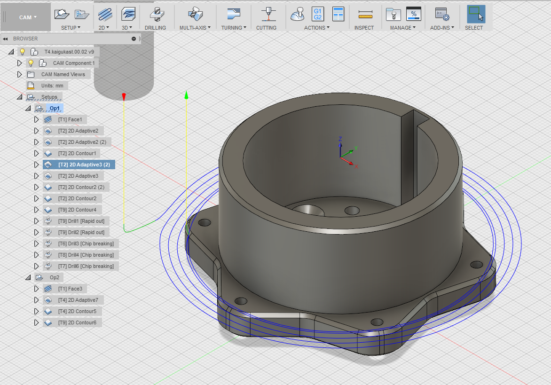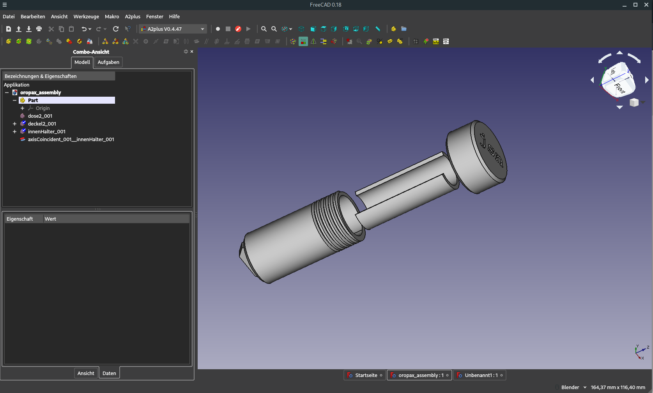
When it comes to CAD software, there are a lot of opinions out there. AutoCAD and SolidWorks being probably the most famous software suites for Computer Aided Design have a LOT of competition. If you still own an old version of either of the two, you are probably happy and don't need to think about other software options. If your interest in the topic started recently, it is not that easy, because most CAD programs only come in a new fashioned license model, where you have to pay an incredible
amount of money regularly without ever owning the software. Now, for a company this might be a good deal, because this type of licensing model usually comes with better service options.
When drawing at home in your freetime, at least for me such a cost factor would not be acceptable. So I had a look at several pieces of software and found three, which were not only good to work with, but are actually free.

If you search for "free CAD" one of your first hits will probably be Fusion 360. If you watch a youtube video of someone drawing something to print on his 3D printer, he will probably use Fusion 360.
If you look for a course on how to CAD, you will probably find something using Fusion 360.
My guess is, that Fusion 360 is the most widely used CAD System among hobbyists and that is not without reason.
Autodesk did create a great software suite when they created Fusion 360 which contains much more than a CAD program. From drawing and designing over to simulating assemblies and doing stress simulations you can render your models and use the cloud based workspaces to do version control and work together in your team.
This is not your typical freeware software and it is not even aimed at hobbyists. Another benefit is, that since Autodesk is also the creator of many other big programs in the business, compatibility with some of the most used pieces of software is also a big plus.
The default way of designing in Fusion 360 is described by a lot of people of more intuitive, than in other programs. This is probably, because you can work a lot with your mouse and can pull and push shapes in the directions you want them to be but have still the possibility to do what is called parametric design, which means, that you enter the parameters of a sketch directly.
One of the things which I really did not like about Fusion is, that the cloud concept is not optional in this software. If you want to work a model, you have to push it in the cloud. You don't have an internet connection, you cannot work. This is really an issue for me, because for me this feels very restricting.
Also, Fusion is - of course - not really, what I would consider free. Usually it costs you around 1000 bucks to use it per year - which is still not that expensive in comparison.
But they used to have a 100k limit on the businesses using it. Which means, if you were a hobbyist, or a small business with less than 100k in sales, you could use the software without cost.
But last year, they changed the conditions overnight and lowered the sales limit to 1000 bucks which means, that a lot of people needed to either change their CAD program or start paying. And for me, that was reason enough to not draw another model in Fusion.
I simply do not want to take the risk of having all my models drawn in Fusion360 to wake up one morning and finding out, that I either pay or have lost all my work.

Another CAD Software which is quite intruguing is Design Spark Mechanical which can be downloaded for free from RS Components. It is one part of a series of free software by RS Components which are compatible to each other.
Design Spark Mechanical is very simple to use and is probably my favorite to create fast and simple models, like a 3D model of electronic components for use with a layout program. You can work out all your models by pushing and pulling shapes with your mouse cursor which works really nice and fast.
When you do larger models, my problem is, that the program does not offer parametric design. If you construct carefully, your can still create good models fast. But if you want to change a few things later, it becomes difficult.
Although it is possible to enter measures on some places, the options to enter constraints is very limited.
This is really the only reason I do not use this software more often.

Another option is to go open source. FreeCAD is a very ambitious project which is around for more than a decade and the most recent stable version is 0.18.
FreeCAD works a bit different than most CAD programs I know, because it is basically a collection of different 'workbenches'. Each workbench has its own purpose. For example can you use the 'part design' workbench to design parts. If you want to add letters or lines, you need to change to the 'draft' workbench.
This is quite strange at first, but you get used to it. Nevertheless, Freecad offers a few quirks like that. That said, FreeCAD offers a lot of possibilities, if you are willing to try it out.
My favorite part of FreeCAD right now is the 'part design' workbench. You can work out a model real fast and everything is properly constrained.
You can also download additional workbenches, for example to assemble multiple parts.
All in all, for me this is the CAD system I use at home. I would (at the moment) not use it professionally. But for everything I need at home, FreeCAD offers tools.
The first FreeCAD I used was 0.14. What happened in the last four stable versions is just incredible. It is really worth it to give it a try and if you do not like it right now, have another look at it in the next version.